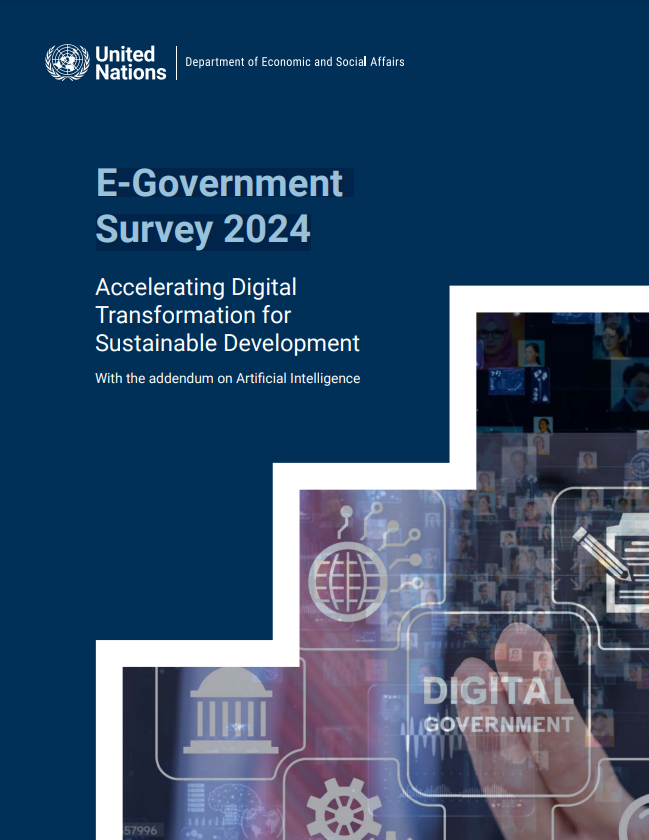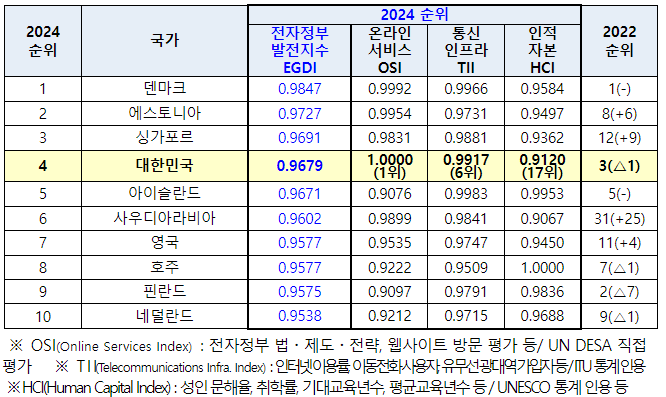
- UN은 2002년부터 2년마다 193개 전체 회원국을 대상으로 홀수 연도에 각국의 '전자정부 발전지수'를 평가하고, 짝수 연도에 그 결과를 발표하고 있음
- 평가 기준은 '온라인서비스 수준', '통신 기반 환경', '인적자본 수준' 3개 분야로, 분야별 결과를 종합해 전자정부 발전지수를 산정함
□ 우리나라 전체 순위는 지난 2022년 평가(3위)보다 1단계 하락했으나, '온라인서비스*' 부문은 2단계 상승해 1위를 차지함
* 전자정부 관련 법·제도·전략, 서비스·콘텐츠 제공 온라인 참여 등 지표 평가
- '통신 기반 환경' 부문에서는 6위, '인적자본 수준' 부문에서는 17위를 기록함
💻 2024년 UN 전자정부 발전지수 상위 10개국

(출처: 행정안전부 보도자료)
[출처] [보도자료] 국제연합(UN), '2024년 유엔 전자정부평가' 발표 (2024.09.19.) / 행정안전부
목차
Preface v
Acknowledgements vi
Acronyms viii
About the survey xix
Executive summary xxi
1. A digital government model framework for sustainable development 1
1.1 Introduction 1
1.2 Two decades of digital development through the lens of the United Nations E-Government survey 2
1.2.1 A brief history of the UN E-Government survey 3
1.2.2 E-Government development index: principles and components 4
1.2.3 Evidence of the role of digital government in accelerating implementation of the 2030 agenda 8
1.3 Towards a digital government model framework 11
1.3.1 Principles for sustainable development and digital development 13
1.3.2 Stakeholders 19
1.3.3 Business drivers for digital government 22
1.3.4 Digital policies, strategies and priorities 26
1.3.5 Measuring and evaluating digital government 27
1.4 The apex of the digital government model framework: achieving sustainable development goals and national development objectives 29
1.5 Key recommendations 30
2. Global trends in E-Government 35
2.1 Introduction 35
2.1.1 EGDI methodology: continuous improvement 35
2.2 E-government rankings in 2024 36
2.3 E-government development at a glance 36
2.3.1 Overall EGDI results 36
2.3.2 Country groupings by EGDI level and movement between the groups 39
2.3.3 Countries leading e-government development 41
2.4 National income and e-government development 42
2.5 Online services index 45
2.5.1 Country groupings by OSI and EGDI levels 45
2.5.2 OSI subindices 52
2.5.3 OSI institutional framework subindex 53
2.5.4 OSI content provision subindex 54
2.5.5 OSI e-participation subindex 55
2.5.6 OSI services provision subindex: progress in online services delivery 61
2.5.7 Targeted services for people in vulnerable situations 65
2.5.8 Sector-specific online information and services: sharing via mobile technologies 67
2.5.9 Technology subindex 67
2.6 Countries in special situations (LDCs, LLDCs and SIDS) 70
2.6.1 E-government development in LDCs, LLDCs and SIDS: trends and insights 71
2.6.2 The OSI and its subindices: progress among the countries in special situations 75
2.6.3 Leaders in digitalization among the countries in special situations 81
Least developed countries 81
Landlocked developing countries 81
small island developing states 82
2.7 Summary of key findings and policy recommendations 83
3. Regional E-Government development and the performance of country groupings 91
3.1 Introduction 91
3.2 Megatrends at the regional level 91
3.3 Crossing the digital divide: progress, challenges and disparities 93
3.4 Africa: country grouping analysis 96
3.4.1 Regional development and cooperation 97
3.4.2 Key recommendations for accelerating digital development in Africa 100
3.5 The Americas: country grouping analysis 103
3.5.1 Regional development and cooperation 103
3.5.2 Key recommendations for accelerating digital development in the Americas 109
3.6 Asia: country grouping analysis 110
3.6.1 Digital development and cooperation 112
3.6.2 Key recommendations for accelerating digital development in Asia 115
3.7 Europe: country grouping analysis 118
3.7.1 Regional development and cooperation 120
3.7.2 Key recommendations for accelerating digital development in Europe 126
3.8 Oceania: country grouping analysis 127
3.8.1 Regional development and cooperation 128
3.8.2 Key recommendations for accelerating digital development in Oceania 131
4. Local E-Government development 135
4.1 Introduction 135
4.1.1 Sustainable cities 135
4.1.2 City portal assessment 136
4.2 Current status of local online services 137
4.2.1 Methodology 137
4.2.2 Current status of local e-government 137
4.3 Smart cities for sustainable development 150
4.4 Local government questionnaire 153
4.5 Application of LOSI methodology in countries 155
4.6 Key findings and recommendations 156
Addendum on AI and digital government 159
A.1 Introduction 159
A.2 AI in the public sector: opportunities and challenges 160
A.2.1 Opportunities 160
A.2.2 Challenges 160
A.3 AI governance and regulatory frameworks 161
A.3.1 United Nations initiatives 162
A.3.2 National AI strategies 163
A.3.3 Human-centric approaches 164
A.4 AI literacy and capacity-building 164
A.4.1 Robust structure for data and digital governance 165
A.4.2 AI literacy 166
A.4.3 Regulatory sandboxes 167
A.5 Key recommendations 168
A.5.1 Building upon existing efforts 168
A.5.2 Laying the appropriate foundations for the advancement of AI technologies 169
A.5.3 Engaging in collective action 169
Annex E-Government Development Index (EGDI) 2024 by countries 172



